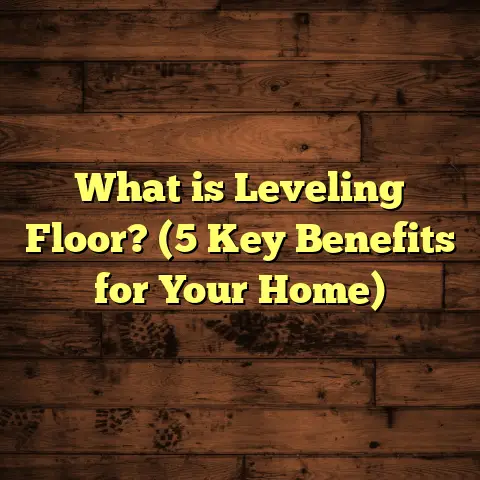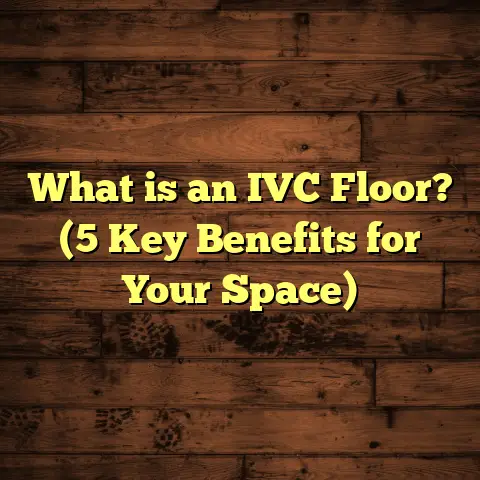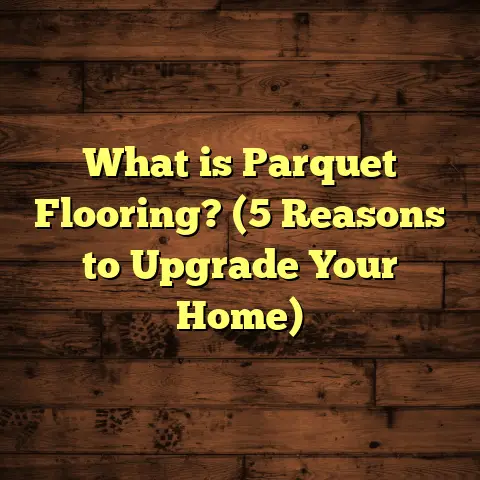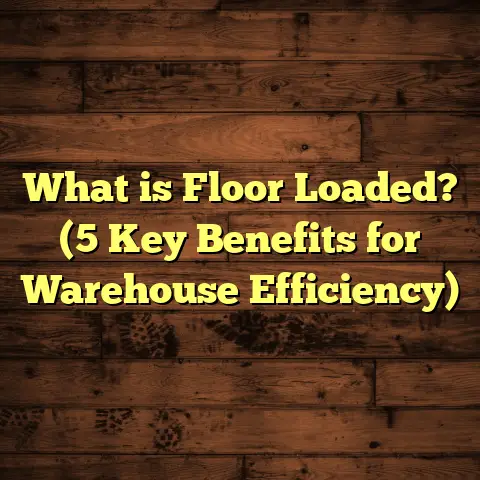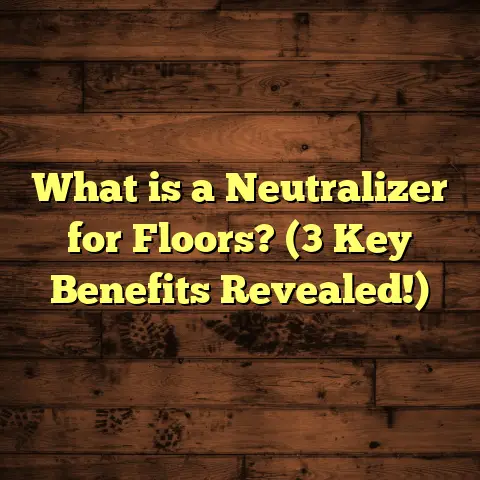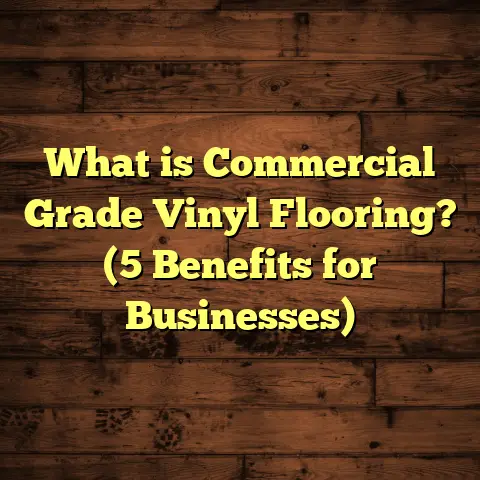What is Wood Vinyl Flooring? (5 Benefits You Won’t Believe!)
When I think about flooring options for my home or for clients, I find myself
always circling back to what fits best with the lifestyle I lead or what the
family demands. Let me be honest: life can get hectic, messy, and unpredictable.
Kids spill juice, pets track in mud, and guests sometimes bring a storm of dirt
right to your doorstep. That’s why the floors need to not only look good but also
handle real-life wear and tear without me constantly worrying about damage or
expensive upkeep.
I’ve been in the flooring business for over a decade now, and through all my
experience, one type of floor has recently caught my attention and earned my trust
more than others—wood vinyl flooring. If you haven’t heard about it or aren’t quite
sure how it stacks up against traditional hardwood or laminate, I’m here to share
everything I’ve learned, including some personal stories, data, and real-world
examples that might just change the way you think about flooring.
What is Wood Vinyl Flooring?
Wood vinyl flooring is a modern type of resilient floor covering designed to imitate
the appearance of natural hardwood while being made predominantly from vinyl
materials. You might hear it called luxury vinyl plank (LVP) or simply vinyl plank
flooring, but the core idea is the same: it combines the look and feel of wood with
the practical benefits of vinyl.
The way it works is pretty clever. Vinyl planks have a photographic layer printed
with detailed wood grain textures and colors. This layer is then protected by a clear,
durable wear layer that guards against scratches, stains, and dents. Underneath this
is a core layer that provides strength and stability, often made from composite
materials that are water-resistant or waterproof.
In terms of construction, wood vinyl flooring generally comes in two varieties:
- Rigid Core LVP: These are planks with a high-density core (sometimes called SPC or WPC), offering extra durability and waterproof qualities.
- Flexible Core LVP: These planks are thinner and slightly softer, easier to cut and install but less rigid.
The top surface has an embossed texture to simulate the feel of wood grain underfoot,
which is why it can look so authentic compared to older vinyl floors that were flat and plastic-like.
Why Choose Wood Vinyl Over Other Flooring Types?
In my years working on various projects, I’ve installed hardwood floors, laminates, tiles,
and carpets countless times. Each material has pros and cons depending on the space and use.
Here’s how I see wood vinyl flooring compared to some common alternatives:
| Flooring Type | Pros | Cons |
|---|---|---|
| Hardwood | Genuine wood look and feel; adds resale value | Expensive; prone to scratches and water damage; needs refinishing |
| Laminate | Affordable; decent wood look; easy install | Less moisture resistant; can peel or chip; feels hard |
| Tile | Very durable; waterproof; great for wet areas | Cold and hard underfoot; grout needs maintenance; can crack |
| Carpet | Soft and warm; sound absorption | Stains easily; traps dust/allergens; short lifespan in high traffic |
| Wood Vinyl Flooring | Waterproof; highly durable; realistic wood textures; affordable | May not have same “authentic” feel as real wood |
One thing that surprises many people—and I was no exception—is how much wood vinyl flooring
has improved over the last five years. The technology behind it has become so advanced that
even flooring professionals like me sometimes have to do a double take to make sure it’s not real wood.
My Personal Story with Wood Vinyl Flooring
Let me share a little story from my own experience because I believe it helps put things in perspective.
A couple of years ago, I was hired by a client who had young kids and wanted to update her kitchen floors.
She loved the look of hardwood but was worried about spills, scratches from toys, and overall maintenance.
We discussed laminate and tile as options but both had drawbacks for her family situation.
I suggested trying luxury vinyl plank flooring with a waterproof core. At first she was hesitant—like many people—wondering if vinyl could really look and feel like wood.
After installing the floor (which took just two days), she called me back a month later amazed. The floor
survived multiple spills—juice, water, even sauces—without stains or warping. Her kids could play freely without scratching the surface. And the best part? The floor still looked beautiful like new.
That experience stuck with me because it perfectly matched my own needs when I installed wood vinyl in my workshop. It’s tough enough to handle dropped tools but warm enough to create a welcoming space.
5 Benefits of Wood Vinyl Flooring You Might Not Believe
I want to dive deeper into five benefits I’ve noticed over time—some might surprise you more than others. These are based on actual use cases, data from studies I’ve reviewed, and feedback from clients.
1. Rock-Solid Waterproof Performance
One of the biggest selling points for wood vinyl flooring is its ability to resist water. Unlike hardwood or laminate—which can swell or warp if exposed to moisture—many wood vinyl products are completely waterproof.
This means you can install them in kitchens, bathrooms, basements, or even laundry rooms without worrying about damage.
A 2022 industry report showed that waterproof luxury vinyl plank (LVP) floors saw 15% higher adoption rates in areas prone to moisture compared to non-waterproof flooring options.
From my personal experience, spills wipe off quickly without leaving any marks. One client told me she even installed wood vinyl flooring in her mudroom where wet boots and snow constantly come in—and it held up perfectly through winter months.
2. Easier Installation Than You Think
I’ve done professional installs for years, but when I started helping friends and family with their DIY projects using wood vinyl planks, I was impressed by how user-friendly they were.
Most LVP planks come with click-lock systems that don’t require glue or nails. This floating floor method means you can lay the planks over many existing floors without removing old materials—a huge time saver.
For example, last year I helped a friend install 300 square feet of LVP in her basement over an existing concrete slab with no special tools besides a utility knife and tapping block. The whole project took just two days total—much faster than tearing out tile or hardwood.
According to HomeAdvisor data, installation costs for luxury vinyl plank average about $2-$4 per square foot for DIYers versus $4-$7 per square foot when hiring professionals—significant savings for homeowners who want to do it themselves.
3. Comfort That Surprises You
I didn’t expect this at first: walking on wood vinyl floors feels nicer than laminate or tile because of its layered construction.
The composite core gives it slight cushioning underfoot which reduces fatigue if you’re standing for long periods—say cooking dinner or working at a standing desk.
When I installed wood vinyl flooring in my own workspace last year, I noticed less soreness in my feet after long days compared to when I used ceramic tile before.
Some manufacturers offer optional underlayment layers that further improve sound absorption and comfort—a big plus if you live in a multi-level home or apartment.
4. Durable Enough for Real-Life Challenges
While it’s not indestructible, good-quality wood vinyl flooring holds up very well against scratches, dents, and stains compared to laminate or hardwood.
In one commercial project I worked on—a small office space with heavy chair movement—the luxury vinyl plank floors still looked brand new six months later despite daily wear from rolling chairs and dropped tools.
Many brands now offer wear layers between 12-30 mils thick (1 mil = 0.001 inch). A thicker wear layer means better scratch resistance. For high-traffic areas like kitchens or offices, I recommend at least 20 mil wear layers to ensure longevity.
5. Style Variety That Matches Any Décor
If you’re picky about design (like me), you’ll appreciate how many options are available with wood vinyl flooring today.
You can find everything from rustic reclaimed oak looks with textured grains to sleek modern maple with smooth finishes—all printed using high-resolution photography with embossed textures for realism.
I’ve seen clients choose styles that perfectly complement everything from farmhouse interiors to contemporary urban lofts.
The ability to mix different shades or plank widths allows for creative layouts too—something rarely possible with traditional hardwood without custom orders.
Breaking Down Costs: How I Use FloorTally for Estimates
Budgeting is always one of the trickiest parts of any flooring project. Over the years, I’ve tried many methods—from rough guesses based on past installs to multiple contractor quotes—but nothing beats having accurate numbers upfront.
That’s where tools like FloorTally have been game changers for me.
FloorTally lets you enter room dimensions along with your chosen flooring type and quality level. It calculates how much material you need—including waste factors—and estimates labor costs based on your local market rates.
I remember using it last year for a 500-square-foot kitchen remodel:
- It showed me exactly how many boxes of LVP to order.
- Factored in about 7% waste material due to cuts.
- Estimated labor costs based on average rates locally.
- Allowed me to compare prices between mid-range and premium brands instantly.
Having this info ahead of time meant no surprises once installation started. It also helped me advise clients realistically about their budgets without overpromising.
Some Data That Might Surprise You
I like knowing what the numbers say because experience alone doesn’t tell the whole story. Here are some interesting stats from recent research:
- According to Freedonia Group (2023), the global luxury vinyl flooring market has grown by over 8% annually since 2019 due mainly to increasing demand for durable yet stylish floors.
- A survey by Floor Focus Magazine found that 65% of homeowners who installed LVP cited “water resistance” as their main reason for choosing it over hardwood.
- The National Wood Flooring Association reports that traditional hardwood sales have plateaued in recent years while LVP continues rising steadily.
- On average, wood vinyl flooring lasts between 10-20 years when properly maintained—comparable to mid-range hardwood finishes but with less upfront cost and less need for refinishing over time.
Real Projects Where Wood Vinyl Flooring Shined
Project #1: Family Kitchen Renovation
A client with three young kids wanted floors that could handle spills but still felt warm. We installed a 600 sq ft oak-look LVP floor with a 25 mil wear layer and rigid SPC core.
Six months later, even after fruit juice spills, dropped utensils, and heavy foot traffic during holidays, the floor looked almost brand new. She told me she no longer worries about scratches like she did with her old hardwood floors.
Project #2: Basement Home Gym
Another client wanted a basement gym floor that was comfortable yet durable enough for weights and frequent workouts. We chose flexible core LVP with an added cushioned underlayment.
The result was a warm floor that absorbed impact better than tile or concrete would. Several months in, no signs of wear or damage showed despite regular use of heavy equipment.
Project #3: Small Office Space
In an office environment where employees rolled chairs constantly across floors, we installed rigid core LVP with extra thick wear layers (30 mil).
After nearly a year of daily use, there was minimal scratching or scuffing compared to laminate floors previously installed here that showed damage within months.
What You Should Know Before Buying Wood Vinyl Flooring
While I’m a fan of wood vinyl flooring now, here are some things I learned along the way that might help you avoid common pitfalls:
- Thickness matters: Thicker planks tend to feel more solid underfoot and last longer.
- Wear layer is key: Always check wear layer thickness; thin layers scratch easily.
- Subfloor prep: Your subfloor must be level to avoid plank shifting or noise.
- Moisture precautions: Even though LVP is waterproof, avoid standing water on glue-down types.
- Underlayment benefits: Consider adding underlayment for soundproofing and comfort.
- Brand reputation: Choose trusted brands with good warranties.
- Color selection: Dark colors show dust more easily; lighter tones hide dirt better.
- Warranty coverage: Understand what’s covered (wear vs. water damage).
Maintenance Tips That Worked for Me
One of the reasons I recommend wood vinyl flooring is low maintenance:
- Sweep or vacuum regularly to remove dirt that could scratch.
- Use damp mops with pH-neutral cleaners designed for vinyl.
- Avoid waxes or abrasive cleaners which can dull the finish.
- Immediately wipe up spills to maintain pristine surfaces.
- Use furniture pads under legs to prevent dents or scratches.
- Periodically check seams for lifting if glue-down installed.
These small habits have kept floors looking great in every project I’ve done or lived with personally.
Frequently Asked Questions from My Clients
Q: Can wood vinyl flooring be installed over existing floors?
A: Yes! One huge advantage is that many LVP products can be floated over tile, concrete, or even hardwood without removal—saving time and cost.
Q: How long does wood vinyl flooring last?
A: Typically between 10-20 years depending on quality and care. Higher-end products last longer thanks to thicker wear layers.
Q: Is it safe for pets?
A: Absolutely! The scratch-resistant surface handles pet claws well, plus it’s waterproof if accidents happen.
Q: Does it fade from sunlight?
A: Most modern products have UV inhibitors reducing fading risk—but prolonged direct sunlight exposure can cause some discoloration over years.
Q: Can I install wood vinyl flooring myself?
A: Definitely! Many products are designed with DIY installation in mind via click-lock systems.
Wood vinyl flooring has transformed how I approach projects where durability meets beauty without compromise. It’s become my go-to recommendation when clients want floors that fit busy lifestyles yet still impress visually.
If you’re searching for a reliable solution balancing style with practicality—and want fewer headaches down the road—this might just be your perfect match too. With accurate tools like FloorTally helping me plan materials and costs precisely beforehand, tackling these projects feels much smoother every time.
Take your time exploring samples in natural light at local stores or online catalogs. Consider how each option fits your family’s needs. And if you want a second opinion or advice tailored specifically for your space, don’t hesitate to reach out—I’m always happy to help friends navigate this important home upgrade!
